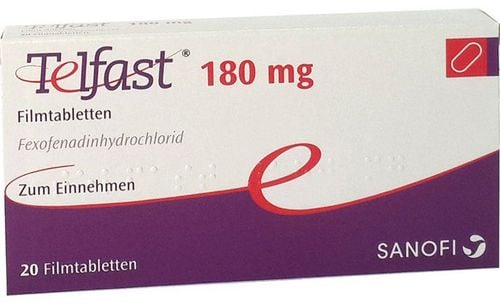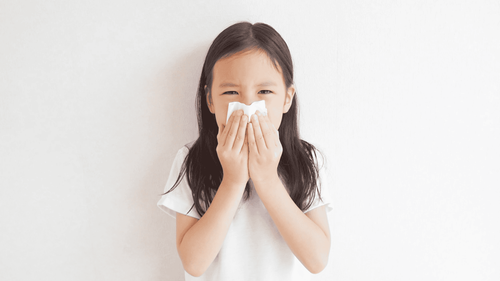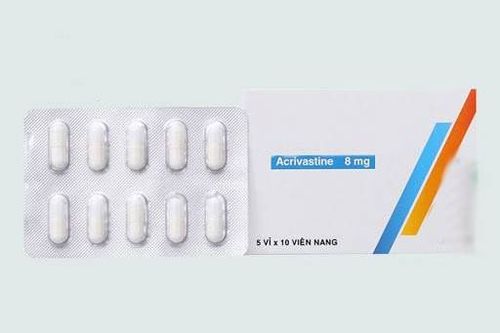This is an automatically translated article.
Antihistamines are a group of drugs that help relieve uncomfortable symptoms caused by allergies such as itchy eyes, sneezing, runny or stuffy nose, and skin rashes like hives. Although most commonly taken in pill form by mouth, antihistamines are also available in liquid, spray, or rectal forms. Therefore, users need to know the following notes when using antihistamines for safe use.1. What is an antihistamine?
Antihistamines are used to relieve or prevent symptoms of allergies such as itchy eyes, itchy nose, runny nose, dry cough, itchy throat, skin rashes, and other allergies. Antihistamines work by blocking the action of a substance called histamine that is produced by white blood cells in the body when exposed to an external allergen. It is the histamine that causes the symptoms of itching, sneezing, runny nose and watery eyes in order to expel foreign substances and set up a protective barrier for the body.The most common antihistamines are taken in pill or liquid form. In addition, this group of drugs is also used in eye drops or nasal drops, nasal sprays, throat sprays. In addition, antihistamines are also given by injection for immediate effect in cases of severe, life-threatening allergic reactions.
Because antihistamines are generally considered safe for most people, including adults, children over 2 years of age, and the elderly, they are readily available at drugstores. However, if you are pregnant or breastfeeding, you should consult your doctor. At the same time, patients with chronic diseases such as cardiovascular disease, arrhythmia, diabetes ... also should not arbitrarily use antihistamines.

Thuốc kháng histamin giúp giảm các triệu chứng của dị ứng
2. What should be monitored when taking antihistamines?
Antihistamines are generally well tolerated in most cases. However, some antihistamines have the side effect of causing drowsiness. Therefore, newer second-generation antihistamines such as loratadine, cetirizine... tend to overcome this shortcoming. In addition, although very rare, antihistamines can also cause side effects such as fast or irregular heartbeat, seizures, hallucinations, difficulty breathing... Accordingly, when these symptoms are present, people Patients need to stop the drug and re-examine soon.
Besides, while taking antihistamines, the patient should avoid drinking alcohol. This is because alcohol can increase the sedative effect of the drug and at the same time, it is important to be careful when taking sedative drugs in combination with antihistamines.

Thuốc kháng histamin có tác dụng phụ là gây buồn ngủ
3. How should antihistamines be used?
Antihistamines are often present quite commonly when patients have symptoms of allergies in some nasopharyngeal diseases, asthma, eyes and even dermatology. However, it should be noted that this is only a group of drugs that treat symptoms rather than drugs that focus on the pathogenesis of the disease. Therefore, it is important for the patient to follow the instructions and instructions of the doctor, to stop the drug as soon as the symptoms have ceased to avoid drug abuse.
Specifically, the amount, the daily dose and the time between doses are dependent on the use of a short-acting antihistamine such as chlorpheniramine or a long-acting antihistamine such as cetirizine. If a dose is accidentally missed, the patient can take it as soon as possible as soon as they remember. However, if it is almost time for your next dose, skip the missed dose and continue your prescribed dosing schedule without doubling your dose to make up for a missed dose.
Instructions for use by each route of administration are as follows:
For patients taking medication by mouth, taking antihistamines should be taken with food or a glass of water or milk to reduce stomach irritation. If taking the extended-release tablet form, the patient should swallow the tablet whole without breaking, crushing or chewing before swallowing to preserve its effectiveness. For patients taking antihistamines to prevent motion sickness, it should be taken at least 30 minutes or, even better, 1 to 2 hours before departure to ensure the medication has time to take effect. .

Sử dụng thuốc trước 30 phút phòng say tàu xe
For patients using suppositories, to insert the drug into the rectal lumen: First remove the wrapper and wet the suppository with water. Then, the patient lies on his side on the bed and uses a finger to push the suppository up into the rectum. If the tablet is too soft, first chill in the freezer for 30 minutes or soak in cold water before removing the wrap. For injectable antihistamines, use should only be made in emergency situations and by medical personnel. Antihistamines should be stored in tightly closed and covered vials, out of the reach of small children. Store the medicine in a cool, dry place, away from direct sunlight at room temperature. Some medicines in liquid or spray form, gel can be covered and stored in the refrigerator, not in the freezer. Pay attention to the expiry date of the drug from the time the lid is opened, especially topical drugs such as eye and nose drops to avoid infection.

Trước khi sử dụng thuốc người bệnh cần được tư vấn về thuốc
In summary, you can take antihistamines in different ways depending on your symptoms to relieve discomfort caused by allergies. However, the best thing is still to limit exposure to allergens, use drugs only when absolutely necessary and strictly follow the doctor's instructions, in order to safely improve symptoms as well as limit the risk of complications. side effects may occur.
Please dial HOTLINE for more information or register for an appointment HERE. Download MyVinmec app to make appointments faster and to manage your bookings easily.
References: poison.org, familydoctor.org












